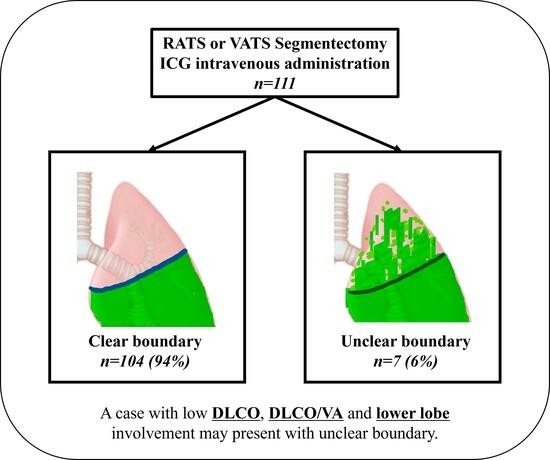Share and Cite
Ueno, H.; Setogawa, T.; Makita, A.; Ohara, Y.; Imamura, Y.; Okado, S.; Watanabe, H.; Kawasumi, Y.; Kadomatsu, Y.; Kato, T.; et al. Influencing Factors on Intersegmental Identification Adequacy in Segmentectomy with Intraoperative Indocyanine Green (ICG) Intravenous Administration. Cancers 2023, 15, 5876. https://doi.org/10.3390/cancers15245876
Ueno H, Setogawa T, Makita A, Ohara Y, Imamura Y, Okado S, Watanabe H, Kawasumi Y, Kadomatsu Y, Kato T, et al. Influencing Factors on Intersegmental Identification Adequacy in Segmentectomy with Intraoperative Indocyanine Green (ICG) Intravenous Administration. Cancers. 2023; 15(24):5876. https://doi.org/10.3390/cancers15245876
Chicago/Turabian StyleUeno, Harushi, Tomohiro Setogawa, Ayaka Makita, Yuko Ohara, Yoshito Imamura, Shoji Okado, Hiroki Watanabe, Yuta Kawasumi, Yuka Kadomatsu, Taketo Kato, and et al. 2023. "Influencing Factors on Intersegmental Identification Adequacy in Segmentectomy with Intraoperative Indocyanine Green (ICG) Intravenous Administration" Cancers 15, no. 24: 5876. https://doi.org/10.3390/cancers15245876
APA StyleUeno, H., Setogawa, T., Makita, A., Ohara, Y., Imamura, Y., Okado, S., Watanabe, H., Kawasumi, Y., Kadomatsu, Y., Kato, T., Nakamura, S., Mizuno, T., & Chen-Yoshikawa, T. F. (2023). Influencing Factors on Intersegmental Identification Adequacy in Segmentectomy with Intraoperative Indocyanine Green (ICG) Intravenous Administration. Cancers, 15(24), 5876. https://doi.org/10.3390/cancers15245876






